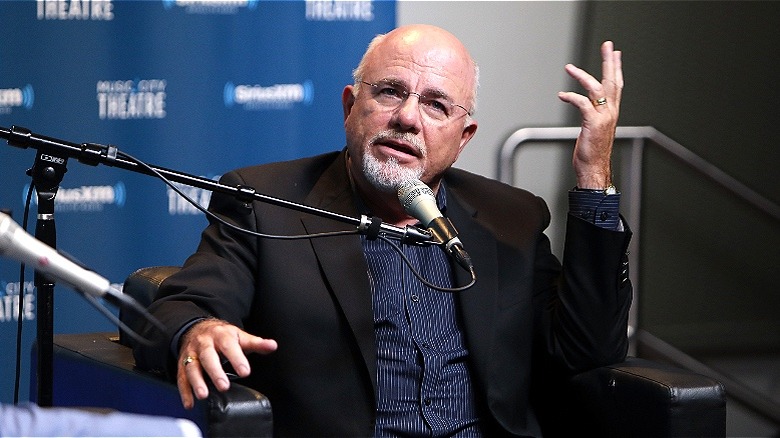Dave Ramsey Reveals The Age People Should Start Taking Social Security, But There's A Catch
The podcaster, writer, and investment analyst Dave Ramsey is well known for his hot takes and interesting opinions on how people can best leverage their financial assets. Ramsey's advice runs the gamut from easy-to-follow "baby steps" that can raise both your financial acumen and stability to abysmal financial advice like sticking to the 15-year mortgage no matter what. He's prominently seen talking to callers on his podcast, providing tailored advice surrounding their unique situations. Many call in with questions about paying off debt or utilizing a backdoor Roth IRA, for instance. Social Security is also a hot-button issue for Dave Ramsey, his cohosts, and callers looking for guidance.
For Ramsey, Social Security isn't a great bargain. The retirement program has long been a concern for workers and retirees in America alike, with dread over insolvency featuring prominently. While the fund isn't going to run out of money, cutbacks to Social Security may ultimately take effect in decades to come if new legislation doesn't allocate additional funding.
Dave Ramsey makes no bones about his distaste for the social safety net, but he does offer a key piece of advice that might be useful for some people approaching retirement. His take on how to best maximize your Social Security checks differs from the traditional approach. Yet, it's a potentially lucrative alternative that can work wonders for some workers' retirement planning efforts.
Dave Ramsey suggests considering early withdrawal
Rather than waiting until you're 70 to utilize the fully matured Social Security payout rate (124%, lifting the maximum monthly benefit from $3,822 to $4,873, in 2024), Dave Ramsey suggests taking your Social Security checks as early as you possibly can. This would give you a maximum payment value in 2024 of $2,710. It's cut down substantially, but there's a catch to this strategy. While you'll be claiming a far lower face value each month from age 62 through to your last payment, you'll gain a different kind of benefit if you're smart with the cash.
Ramsey's strategy hinges on a twofold approach. Firstly, you won't actually be retiring at 62, just taking the checks as early as the Social Security Administration is willing to cut them for you. The result is an inflated cash flow in the final years of your working life; however, this doesn't mean you should start splurging. Instead, the follow up to this decision is a commitment to investing the entirety of these checks in a structured retirement account that focuses on growth and principal defense.
Low-cost mutual funds, broad market exchange-traded funds, and similar investment options make for good selections here. Ramsey's thinking is that investors who are astute with their investment strategy can build a greater volume of capital appreciation with the money in the years leading up to their actual retirement date than the Social Security checks can provide if left alone to accumulate value on their own.
Investing the entire sum is key to making this work
Dave Ramsey is consistent in his thinking on a great many financial realities, and these strong feelings don't always jive with the priorities, needs, and realities of others. For Ramsey, maintaining zero debt is a personal point of pride. This means he's capable of investing the windfall of any new incoming check in its entirety. As a result, Ramsey's line of thinking here centers on an ability to invest the entire sum of the Social Security check proceeds.
For a recipient earning the maximum Social Security payout, that means investing $2,710 every month and not a penny less ($32,520 in a single year on top of your existing contribution strategy; certainly not chump change!). Ramsey noted in a 2019 installment of his podcast, "it usually makes sense to take it early if you're going to ... invest every bit of it." That's the key to making this strategy work. For employees who aren't leaving the workforce at 62 and plan to utilize their Social Security payments in the traditional format, waiting to take these benefits generally makes the most sense because each delayed year translates into more money each month.
Moreover, 62 counts as early retirement these days, with full retirement age coming at 66 or 67, depending on the year you were born. If you were to take these benefits and then filter them into your routine budgeting, you would be severely undercutting your eventual payouts. Instead, investing the entire sum can generate a major influx of capital straight to your retirement-planning funds. Inflating your contributions in your final years like this can dramatically improve the principal available to generate retirement income when you ultimately do make the decision to hang it up.
Waiting can provide key benefits, so a solid plan is crucial
Dave Ramsey certainly has a point in suggesting an alternative accumulation strategy for Social Security benefits. Invested in a solid growth selection, this money can absolutely thrive, providing a massive surge in value for your savings portfolio. However, there are plenty of pitfalls between a worker eying retirement on the horizon and early benefit claims.
For starters, Social Security checks count as income, and are therefore taxable, depending on other factors in your financial life. For someone still engaged in the workforce, this is almost guaranteed to be the case, perhaps even significantly depreciating the payout's value in the short term. It may not ultimately add the huge boost you're hoping for after taking the additional tax burden into account.
In another vein, this investment strategy does little to buoy retirement savings if the capital will be utilized to pay for everyday expenses. Taking the money now freezes its appreciation, that fact can't be overstated. Forgoing continued growth only to utilize the funds on a current expense load can be done in a true emergency, but this approach may only stave off dire circumstances for a short time.
Lastly, in order to make this Social Security investment strategy truly viable, you will need to be a committed investor already. Those who aren't already exploring investment opportunities may be ill-equipped to find growth assets that can balloon the value of this funding. Even if you are investing the entirety of your Social Security payout, if it's placed in an underperforming asset you won't be achieving the key financial goal necessary to make the choice valuable.



